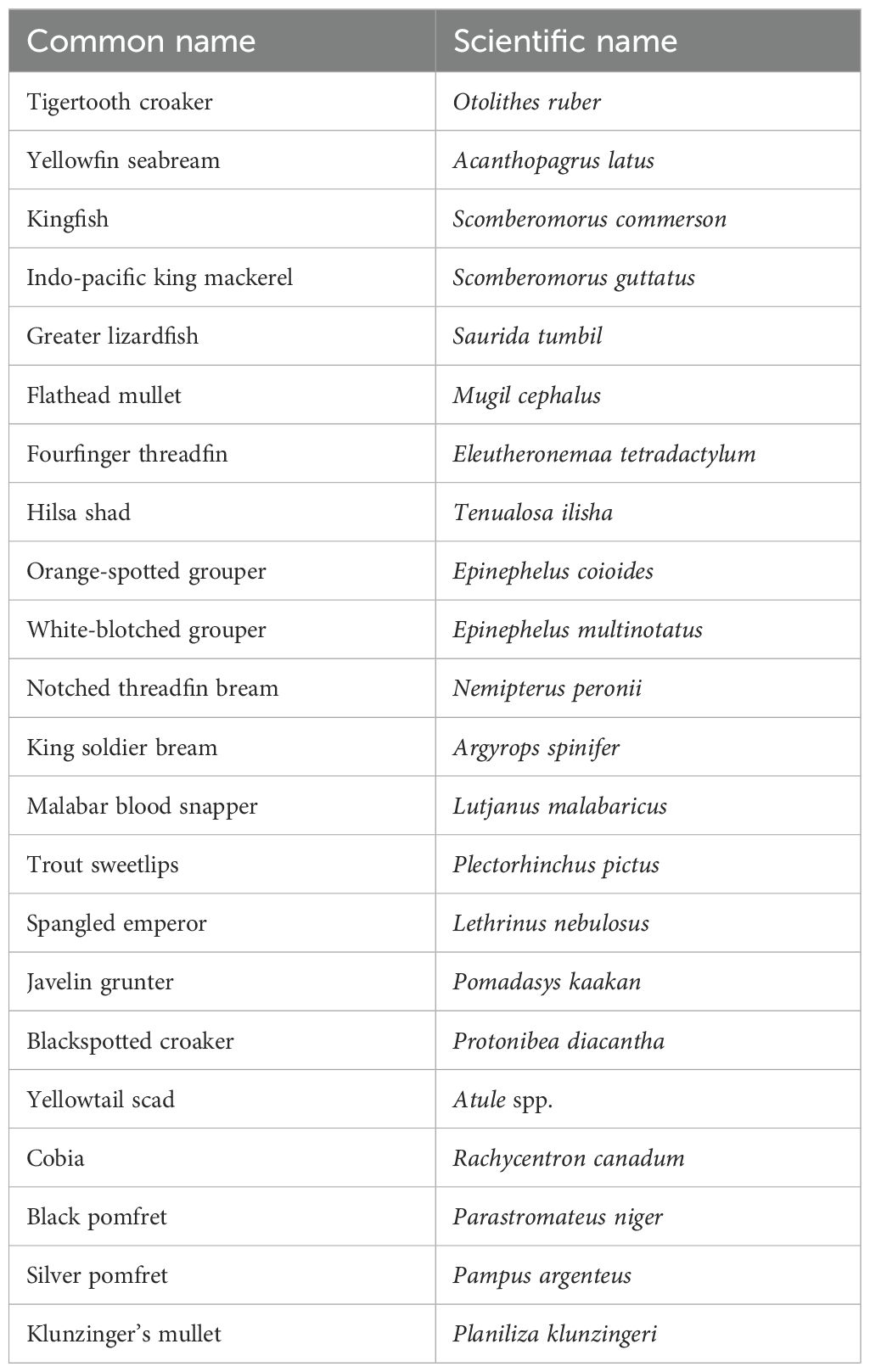- Marine Science Department, College of Science, Kuwait University, Kuwait City, Kuwait
Seasonality in fisheries is known when opening and closing dates are established, but it is much less defined in places lacking seasonal regulations. Highlighting fisheries seasonality is critical because, for one, it can influence seafood supply and prices. Here, we examine fisheries seasonality by analyzing extensive datasets of monthly commercial landings and prices spanning over twenty years for 22 major finfish stocks in Kuwait, where seasonal closures are uncommon. Additionally, we develop a questionnaire to obtain information from the recreational fishery—the only fishing sector composed of local fishers—to investigate whether peak commercial landing months overlap with local fishers’ knowledge. We found a distinct seasonality in finfish commercial landings: at the two ends of the spectrum, the strongly winter-spring finfish landings (60% or more of landing proportions), which plummet sharply over warmer months, and the strongly summer-fall finfish landings. Landings influenced seasonal mean prices, with higher landings generally meant lower prices and vice versa. Further, we found that months identified by local fishers as being the “best fishing seasons” are consistent with months of peak landings for most stocks, though fishing seasons for a few stocks diverged widely from seasonality in commercial landings. Broadly, our analysis underscores high seasonality unrelated to seasonal regulations and supports combining commercial landings and local fishers’ knowledge to understand fishery and finfish seasonality, particularly in data-limited situations.
1 Introduction
Fisheries provide a crucial source of protein and micronutrients for numerous communities worldwide (Kawarazuka and Béné, 2010; FAO, 2020). Locally caught seafood is often preferred, but its supply can be seasonal due to various factors. One factor that clearly defines fishery seasonality is the regulatory initiatives that management agencies impose, including seasonal closures (Shen and Heino, 2014; Anderson et al., 2018; Ben-Hasan et al., 2019). Such a regulatory initiative specifies a start date aimed at reducing or preventing the capture of fish when they are too small (i.e., avoiding growth overfishing) and a closing date that generally aims at ensuring adequate spawners left that produce strong cohort for later years (i.e., avoiding recruitment overfishing). Consequently, fish landings only occur in specific months of the year (Walters and Martell, 2004; Ben-Hasan et al., 2019). On the other hand, in the absence of temporal management interventions, seasonality in landings and prices may be driven by, for example, seasonal migrations or dispersal patterns of exploited species, which affects the seasonal catchability/availability of fish (Arnold and Metcalfe, 1996; Queiroz et al., 2016; Feeley et al., 2018; Perez et al., 2019). For example, many fish species spend part of their life in the juvenile nearshore area (e.g., coral reefs, estuaries, and mangroves), where they are generally not vulnerable to fishing gears, then migrate to a separate offshore adult area, where their area overlap with fishing grounds (Longhurst and Pauly, 1987; Aguilar-Perera and Appeldoorn, 2008). Underscoring the “natural” interannual changes in fisheries seasonality is critical because it can influence seafood supply and prices and help inform data collection designs of seasonal fish.
Local fishers’ knowledge plays a crucial role in understanding fish population dynamics and seasonal variability in behavior, catch, and abundance of exploited species (Johannes et al., 2008; Silvano and Valbo-Jørgensen, 2008; Martins et al., 2018; Pita et al., 2020; Bastari et al., 2022; Obregón et al., 2022). In many aquatic ecosystems, studies showed that this knowledge is often consistent and complements other sources of information (e.g., quantitative data), provides new insights or updates previous conclusions, and is relatively cheap, accessible, and quick to gather (Johannes et al., 2008; Monkman et al., 2018; Lopes et al., 2019; Bastari et al., 2022; Obregón et al., 2022; Boubekri et al., 2023; Daliri et al., 2023). For example, an assessment of changes in the sizes of blue swimmer crabs in two estuaries off south-western Australia—Peel-Harvey and Swan-Canning—used the knowledge of local recreational fishers, which indicated that crabs were much smaller in Peel-Harvey; this finding was in line with both historical records (e.g., newspapers) and conventional quantitative data on the size of crabs (Obregón et al., 2022). Further, including local fishers’ knowledge to investigate the seasonality of fishing for baitfish predators in the Solomon Islands helped in correcting their contribution to artisanal catch to 54% of the total catch, which has been grossly underestimated in previous research to be around 1% (Johannes et al., 2008). Therefore, the incorporation of knowledge from local fishers in research studies and policy-making has proven to be valuable, especially where relevant data are limited (Neis et al., 1999; Johannes et al., 2008; Bastari et al., 2022; Castello et al., 2024).
In this paper, we examine Kuwait finfish fisheries as a case study to underscore unregulated seasonality in fisheries for several reasons. First, most exploited finfish stocks lack seasonal closures imposed by the management agency. While it is perceived that landings and prices for some finfish stocks are highly seasonal—e.g., seafood supply of some seabream and croaker species increase during colder months but plummet sharply in the summer season—a clear understanding of seasonality in fisheries has not been established for most finfish stocks. Second, the availability of twenty-year datasets of landings and prices, which are reported every month for 22 finfish stocks. Finally, the possibility of highlighting and comparing seasonality from two different sources: (i) commercial landings obtained from artisanal and industrial sectors that are composed of foreign fishers, and (ii) local knowledge that is concentrated within the recreational sector.
Our contribution attempts to answer the following questions: (i) how commercial finfish landings and their prices are changing seasonally? (ii) from local fishers’ standpoint, what is the meaning of fisheries seasonality? and (iii) how seasonality in commercial finfish landings aligns with the knowledge of local (recreational) fishers? To answer question (i), we analyze the official landing and price datasets reported for all finfish stocks. To answer questions (ii) and (iii), we complement the commercial landings dataset with local fishers’ knowledge by developing and distributing a questionnaire among local fishers. We conclude by discussing some important considerations and implications of establishing a clear recognition of seasonality in fisheries.
2 Methods
2.1 Study area
In Kuwait, fishing bears a significant cultural value as pearl diving used to be one of the country’s main economic activities—and today, seafood is a staple diet (Grandcourt, 2012). Fish per capita consumption has been steadily rising, from ~ 7 kg per capita to 15 kg between 1961–2021, and it is expected to continue growing in the future (Ritchie et al., 2023). Kuwait fisheries use different fishing gears to target a suite of species, but they can be broadly divided into two main types: shrimp fishery and finfish fishery (Al-Husaini et al., 2015). Trawlers mainly target the shrimp stock, and seasonality in shrimp fishery is defined by setting seasonal opening and closing dates, which start around August/September and approximately close in February/March (Al-Husaini et al., 2015).
For most finfish fisheries, however, seasonality is less well-known as seasonal closures are uncommon. Different fishing sectors target finfish in Kuwait: artisanal and industrial—both fishing for profit—and recreational, which fish to maximize their leisure and experience (Al-Abdulrazzak et al., 2015; Al-Husaini et al., 2015; Ben-Hasan and Daliri, 2022). Artisanal and industrial fisheries (collectively referred to as “commercial fisheries”) use different fishing gears—e.g., gillnets, traps, and trawling; on the other hand, recreational fishers mainly use the traditional hook-and-line (Ben-Hasan and Daliri, 2022).
2.2 Commercial landing and price datasets
We compiled landing and price datasets from the official Annual Bulletin of Fisheries Statistics found online on the Central Statistical Bureau website, published for 2000–2019 (Central Statistical Bureau, 2024). In these bulletins, both local landings and prices (wholesale prices) for 24 species/groups of exploited fish and invertebrates are recorded monthly and annually (Central Statistical Bureau, 2024). Because prices are reported in local currency, Kuwaiti Dinars (KWD), we have converted them to U.S. Dollars using the World Bank yearly exchange rate (World Bank, 2021). Specifically, we divided the official average prices reported as KWD/kg by 0.3, which is the average exchange rate for 2000–2019.
Out of these 24 species/groups, we omitted shrimp because seasonal closures regulate its landings; therefore, seasonality is well-recognized (Al-Husaini et al., 2015). On the other hand, while some fisheries regulations exist for finfish, such as size limitations and general spatial closures, seasonal closures are lacking for most exploited finfish species. We also omitted the “Others” or miscellaneous group since its species composition is unknown. Therefore, our analysis focused on the locally landed 22 finfish stocks (Table 1). It should be noted that the recorded landings are generally caught by the artisanal and industrial sectors, though they are mostly caught by the former (Ben-Hasan and Daliri, 2022).
2.3 Survey of local fishers’ knowledge
The rising income level of local people—due to the discovery of oil—significantly changed the fishing community: most locals now practice fishing as a recreational activity. On the other hand, commercial fisheries are mainly practiced by foreign fishers (Al-Abdulrazzak et al., 2015). While artisanal and industrial fisheries are the major sectors contributing to total landings, local fishers’ knowledge is concentrated within the recreational fishers in Kuwait.
Therefore, in addition to analyzing the commercial landing and price datasets, we developed and disseminated a digital survey to gather local fishers’ knowledge by focusing on recreational fishers (Supplementary Material A). The survey consisted of 10 questions that generally sought information on the seasonality of 13 finfish stocks commonly known by local recreational fishers (but may or may not be targeted) (Al-Husaini et al., 2015).
As most fishers speak Arabic, the survey was distributed and filled in Arabic; however, we provided both the Arabic and English versions in the supplementary section. We sought the perception of the local recreational fishers to gain insights independent of commercial landing data.
3 Results and discussion
3.1 Seasonality in commercial finfish landings and prices
The total finfish landings showed strong seasonality: colder months (November–April) are, on average, associated with much higher landings than warmer months (May–October) (Figure 1). The mean landing over the colder months is 10.7 tons, whereas it is 8.5 tons for the warmer months (Figure 1). This highlights a seasonal switching between target stocks, which is common in multispecies fisheries in general (Jin and Tang, 1996; Henderson et al., 2007; Martínez-Ortiz et al., 2015). Indeed, we observed clear patterns in stock-specific landings: at the two ends of the spectrum, the (i) strongly winter-spring finfish, which are mostly (60% or more of landing proportions) caught during the colder months (December–first half of May); and the (ii) strongly summer-fall finfish, which are mostly caught during the warmer months (second half of May–November) (Figure 2, Table 2). (Figure 2). To illustrate, the landing proportions of target stocks, such as Tigertooth croaker, Yellowfin seabream, Kingfish, and Indian-Pacific king mackerel are largest in colder seasons (December–March/April) relative to their total seasonal landings (Figure 2). However, the landing proportions of these stocks drop in warmer seasons while the landing proportions of other stocks—particularly Klunzinger’s mullet and Silver pomfret—sharply increase (Figure 2). It should be noted that, unlike the other finfish species, seasonality in Klunzinger’s mullet is largely determined by seasonal closure set by the management agency. Since 2014, the fishing season for Klunzinger’s mullet has been consistently closing in December and opening again in June (Supplementary Material B, Supplementary Figure S1). While there is a seasonal closure for Silver pomfret, it is limited to only 45 days (Al-Husaini, 2003).
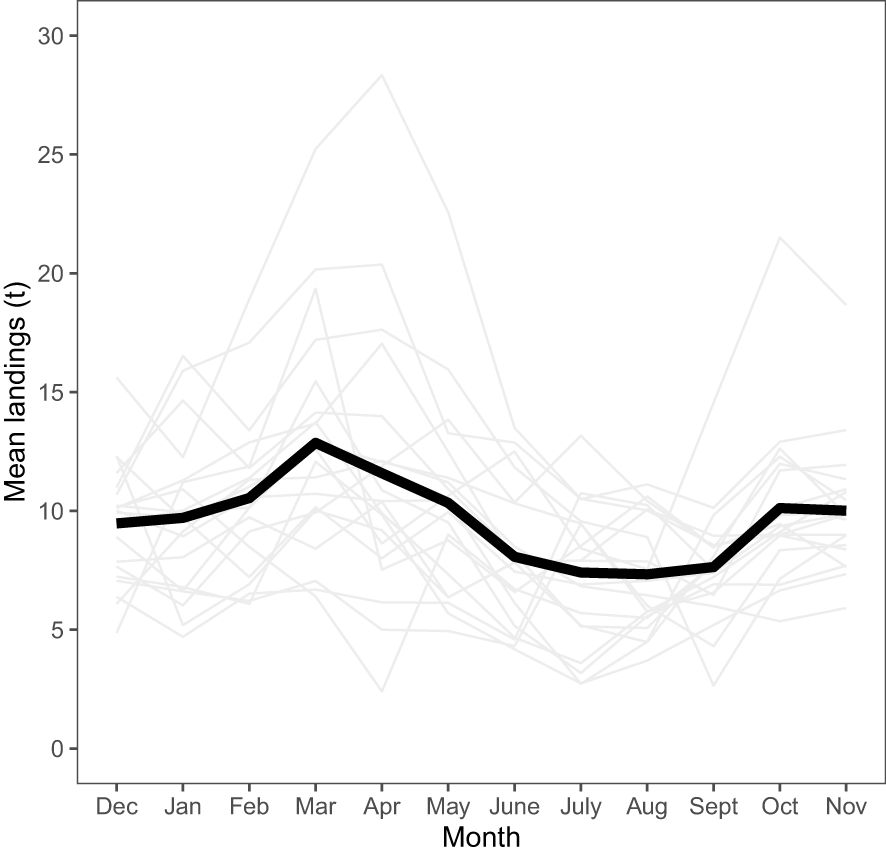
Figure 1. The overall within-season mean landings across all examined stocks and years (black line; 2000–2019). Grey lines represent individual years. Note that December is the start of the winter season in Kuwait (Supplementary Material C, Supplementary Table S1).
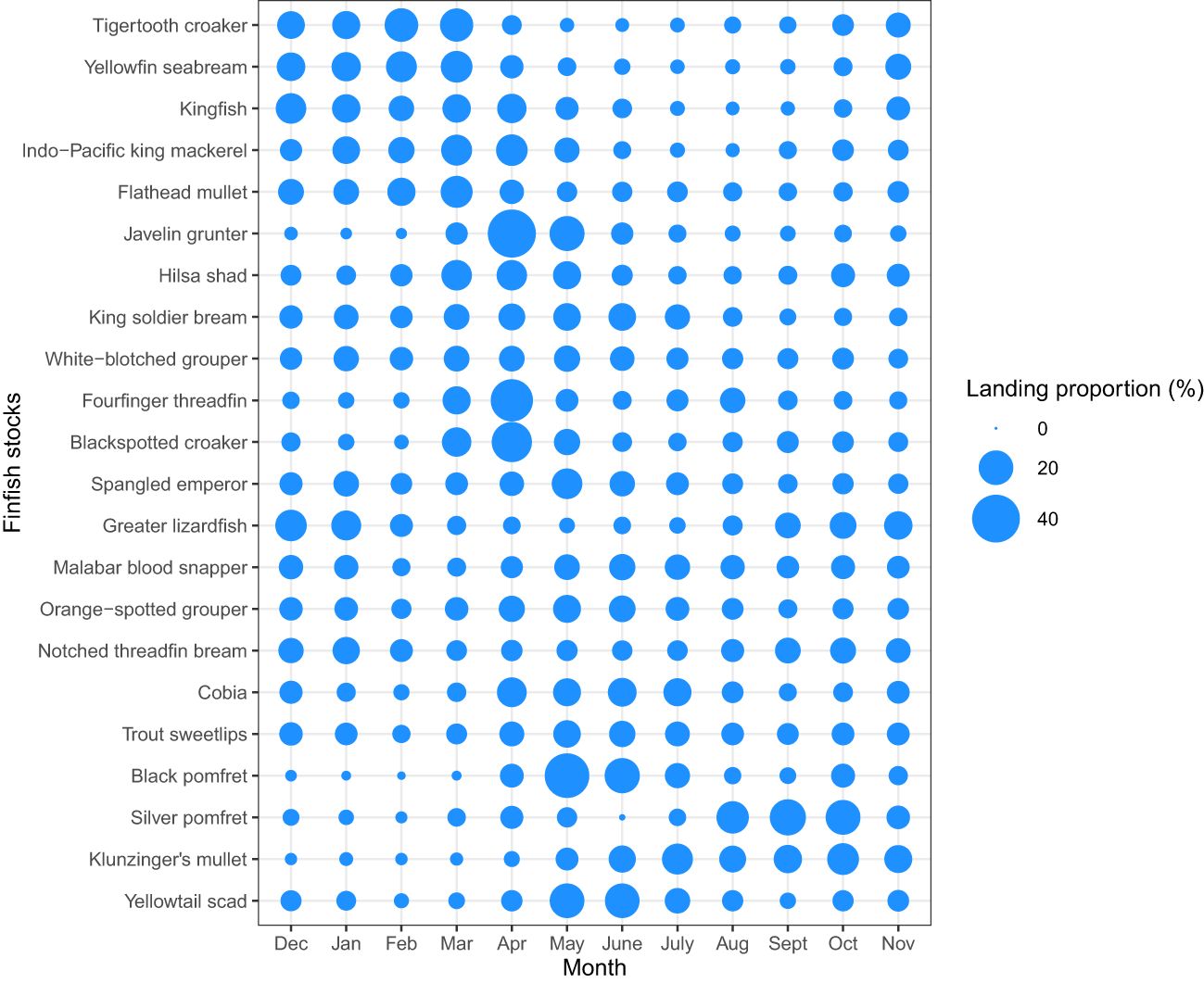
Figure 2. Within-season landings of each finfish stock relative to their total seasonal landing across all years (2000–2019; Supplementary Material C, Supplementary Table S2). Both Klunzinger’s mullet and Silver pomfret are regulated through seasonal closures: Klunzinger’s mullet season has been consistently closing in December and opening again in June since 2014, and there is a 45-day fishing ban for Silver pomfret over May and June. Note that December is the start of the winter season in Kuwait (Supplementary Material C, Supplementary Table S1).
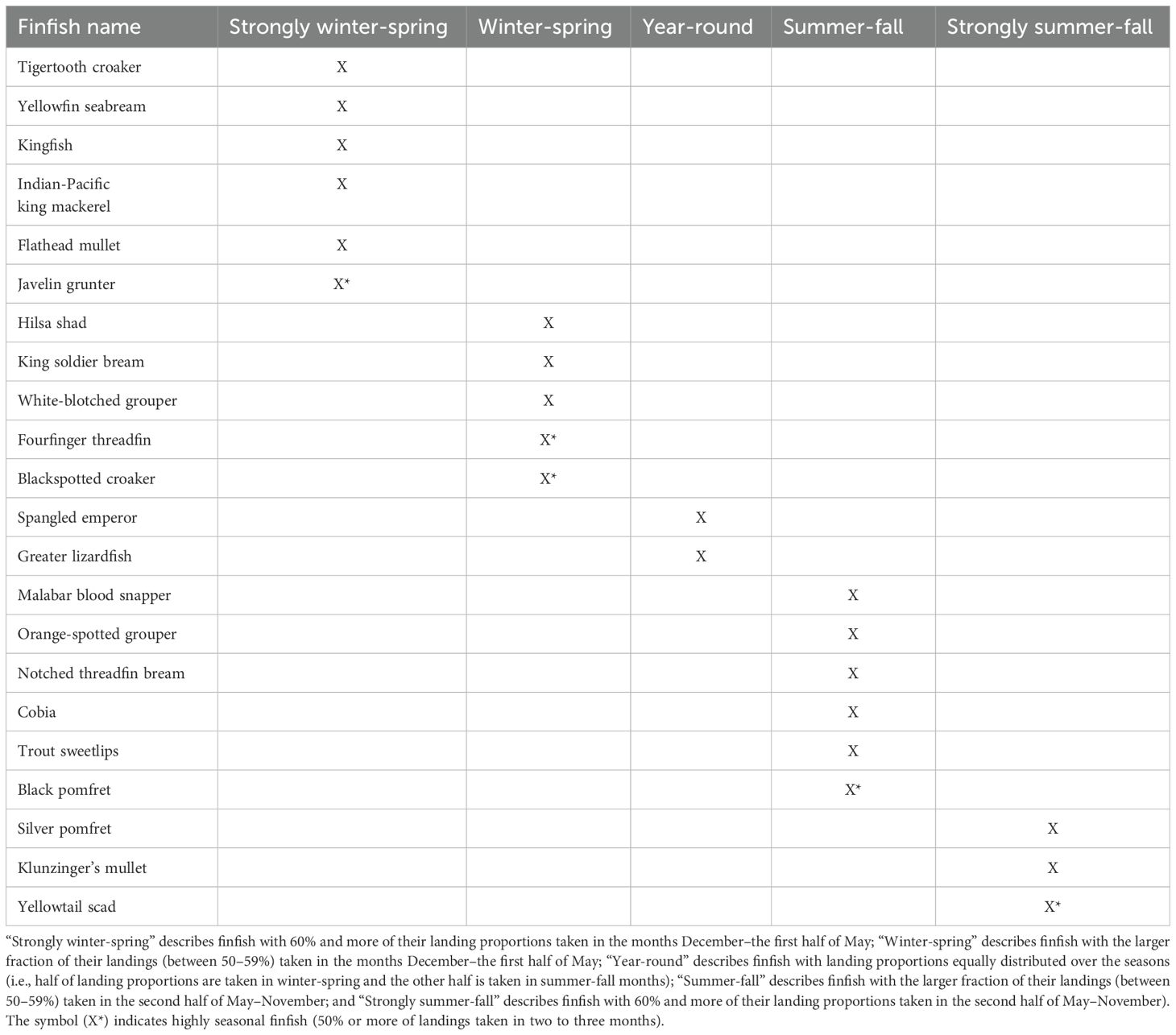
Table 2. Finfish landings grouped by seasons in terms of stock-specific landing proportion for each month relative to the total landing taken across 20 years (2000–2019).
A weaker seasonality in commercial landings is observed for stocks categorized under winter-spring and summer-fall seasons. For instance, a larger fraction (50%–59%) of the landings for Fourfinger threadfin and Hilsa shad stocks occur in winter-fall, whereas Orange-spotted grouper and Notched threadfin bream are much more landed during summer-fall (Figure 2, Table 2). There are species that do not show seasonality, as shown by their relatively stable landing proportions over the season (Greater lizardfish and Spangled emperor); in contrast, Javelin grunter stock is highly seasonal, with more than half of the total seasonal landing occurring in only two months of the year (Figure 2, Table 2).
There are many drivers of seasonality in landings unrelated to regulatory initiatives (e.g., seasonal closures). One of the main causes that can influence within-season landings is the seasonal migrations/dispersal patterns of exploited species. For example, numerous fish species undergo onshore-offshore movement as they transition to adulthood (Longhurst and Pauly, 1987; Walters and Martell, 2004). Such a behavior potentially makes exploited species available to the fishery only for part of the season. Klunzinger’s mullet, for instance, inhabit the nearshore areas when they are juveniles (< 9 cm) between March and June, and they have no commercial value (Alsaffar et al., 2019). As fish grow in size, they recruit to fishing grounds and so become vulnerable to fishing gear. Silver pomfret is believed to migrate southward to deeper waters from November to March, but between March and October, it migrates northward, where it is exploited by fisheries in Kuwait and Iran (Al-Husaini, 2003; Ben-Hasan et al., 2020). The perceived migratory pattern of Silver pomfret is consistent with the in-season landing proportions, which increase starting from March—with the exception of the 45-day ban over the May–June period—and the largest proportion (60%) of the total seasonal landings occur between July to October (Figure 2). In addition to Klunzinger’s mullet and Silver pomfret, Kingfish is known to conduct long-distance migrations in the Gulf region (Hoolihan et al., 2006); however, for most exploited finfish species in Kuwait, there is a significant gap in the knowledge of life history trajectory.
Another possible driver of landing seasonality is fishers’ switching to target alternative species. A likely switching behavior in the examined within-season landings can be seen when comparing the landings of the two similar species, the Flathead mullet and Klunzinger’s mullet (Supplementary Material B, Supplementary Figure S1). The monthly landing patterns for these two species suggest that once a seasonal closure for Klunzinger’s mullet is initiated (i.e., when landings are zero), landings for Flathead mullet soar. Nevertheless, when fishers can catch and land Klunzinger’s mullet, landings of Flathead mullet are notably lower (Figure 2; Supplementary Material B, Supplementary Figure S1). A similar switching behavior is seen in, for example, the Gulf of Carpentaria prawn fishery, where fishers switch from day-time trawling for banana prawns to night-time trawling for other prawn species. When banana prawns are scarce, the fishery is either closed early or the fishers cannot find them and so switch earlier and generate more impact on the other species (Somers and Wang, 1997).
For the majority of finfish stocks, the mean within-season price of fish landed is in contrast with the proportion landed: higher fish prices are associated with fewer landing proportions and vice versa (Figure 3). For instance, the mean within-season prices for Tigertooth croaker and Yellowfin seabream are lowest between December and March when landing proportions are highest. This landing-price trend is also applicable to the highly-seasonal species (e.g., Fourfinger threadfin and Javelin grunter), where prices drop in the few months of high landing proportion but rapidly rebound once the landing proportion falls. The seasonal price trends for Klunzinger’s mullet and Silver pomfret are exceptions to this trend—the prices increase dramatically with higher landing proportions after the fishing ban is lifted (Figure 3). The increase in prices with landings is likely primarily driven by the high demand after seasonal closures. Indeed, this can be clearly observed in the shrimp stock, where landing quantities and prices increase after opening the shrimping season (Supplementary Material B, Supplementary Figure S2).

Figure 3. Within-season landing prices of finfish. Landings for each finfish stock are relative to their total seasonal landing across all years (2000–2019; Supplementary Material C, Supplementary Table S2). Both Klunzinger’s mullet and Silver pomfret are regulated through seasonal closures: Klunzinger’s mullet season has been consistently closing in December and opening again in June since 2014, and there is a 45-day fishing ban for Silver pomfret over May and June. Note that December is the start of the winter season in Kuwait (Supplementary Material C, Supplementary Table S1).
3.2 Local fishers’ knowledge
A total of 227 local fishers completed the survey online, with the majority (90%) identified as recreational fishers (Supplementary Material B, Supplementary Figure S3). Most fishers had extensive fishing experience: 71% have over a decade, and about a quarter have more than 25 years of experience in fishing (Supplementary Material B, Supplementary Figure S4). Also, most local fishers indicated that they have knowledge of the seasonality of the most commonly caught finfish (Supplementary Material B, Supplementary Figure S5). Although they perceived the concept of fishing seasons in different ways, about half of the respondents (53%) associated the term “seasonality” with the time when fish are available to catch (Figure 4); most of the other half interpreted “seasonality” to be pertinent to official seasonal closures and the size of fish (Figure 4). The interpretation of seasonality by half of the respondents—i.e., the availability of fish—does not only indicate the “meaning of seasonality”, but also suggests that the availability of fish drives the fishing behavior. However, variation in the availability of fish to at least some fishing gears may vary seasonally due to two possible factors: (i) seasonal onshore-offshore movement of fish and (ii) fish migrations out of Kuwait’s exclusive economic zone (EEZ) to nearby EEZs (Al-Husaini et al., 2015; Alsaffar et al., 2019; Ben-Hasan et al., 2020). Thus, “availability” may be species-specific in terms of causes of seasonal variation.

Figure 4. Local recreational fisher interpretations of fishing seasonality and corresponding response percentages (n = 227 responses).
Additionally, when asked about the seasonality of selected finfish stocks, local fishers’ responses were consistent with the commercial seasonal landings for the majority of stocks while widely diverged for others (Figure 5, Table 3). Fishers’ responses agreed or closely overlapped with the landing proportions of 6 of 11 selected stocks (Table 3). For example, for strongly seasonal finfish, including Tigertooth croaker, Kingfish, Indian-Pacific king mackerel, Silver pomfret, and Klunzinger’s mullet, fishers’ responses and landing proportions were in agreement; while the landing proportions of Javelin grunter are strongly winter-spring, the majority of fishers’ responses were winter-spring (Figure 5, Table 3). It should be noted, however, that the knowledge of Klunzinger’s mullet fishing season is likely influenced by the 6-month seasonal closure rather than having emerged from the fishing experience. This agreement between local fishers’ knowledge and commercial landings supports the strong seasonality of these finfish stocks. This could also explain the difference in seasonality for stocks with less seasonal variation, including Fourfinger threadfin and Orange-spotted grouper (Table 3). Indeed, the interannual landing proportions for these two finfish do not vary dramatically over the season—except for Fourfinger threadfin landings in March (Figure 2). Similarly, fishers’ responses to seasonality in Fourfinger threadfin and Orange-spotted grouper seem to be more evenly distributed over the season; for instance, the largest fractions of the total responses for the best fishing season of Orange-spotted grouper were 38.9% for spring, 23.5% for summer and 24.8% for year-round (Figure 5). In general, our results are consistent with those from other studies, which suggest that local fishers show a deep understanding of fishery seasonality. For example, in some parts of the Solomon Islands and Brazil, local fishers identified fishing seasons of targeted species and categorized fish based on seasons and depth (e.g., “fishes of winter”, “fishes around all year” or “bottom fish”) (Neis et al., 1999; Johannes et al., 2008; Medeiros et al., 2018).
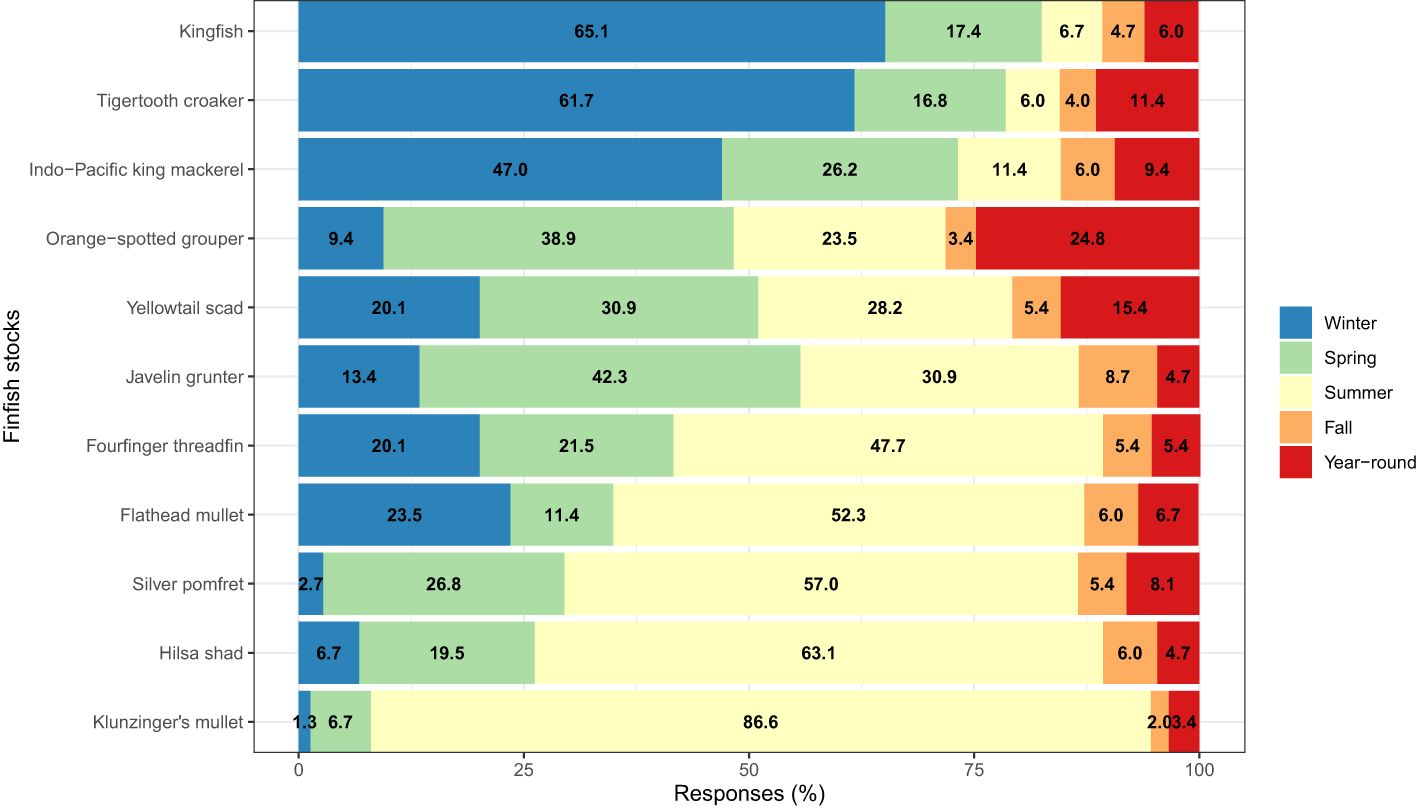
Figure 5. Best fishing season for selected commonly known and caught finfish by local recreational fishers (n = 149 responses; Supplementary Material C, Supplementary Table S3).
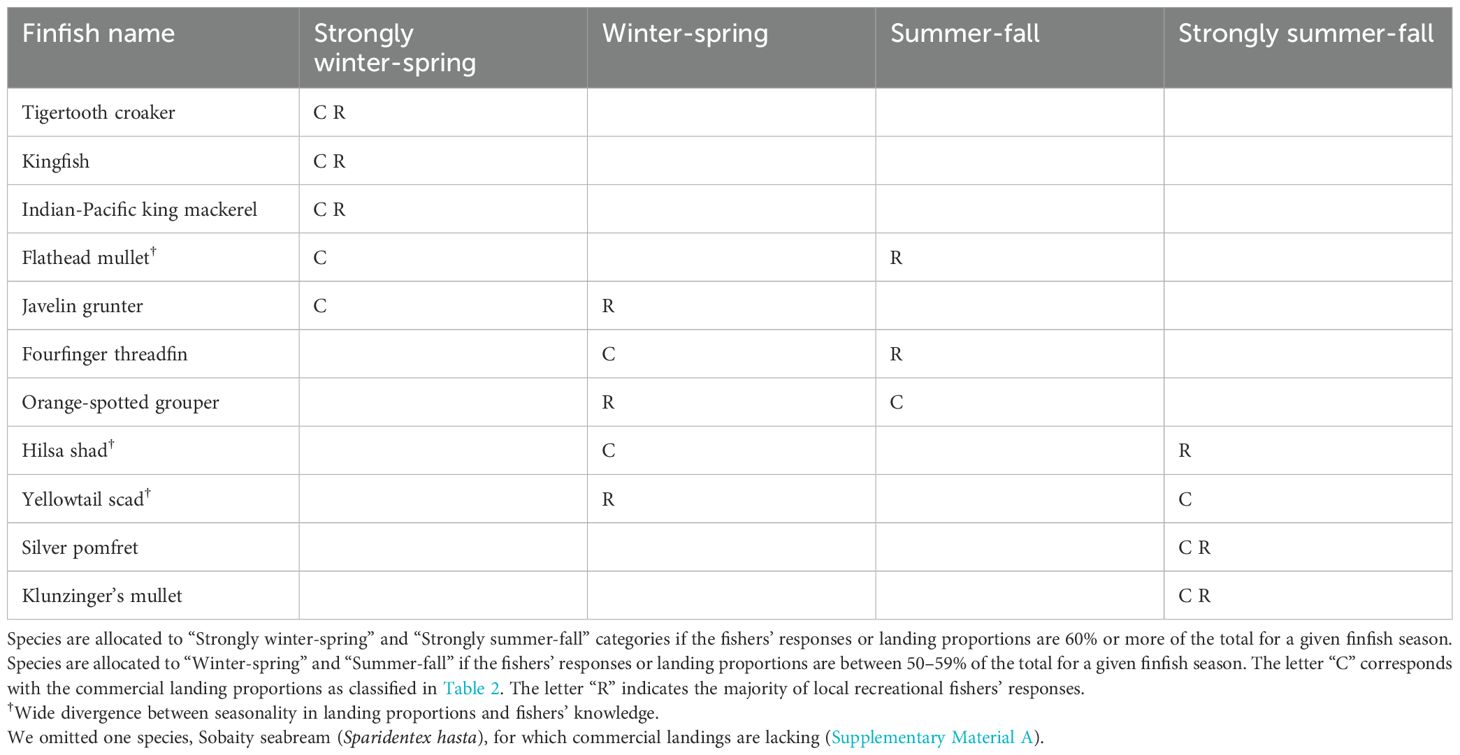
Table 3. Comparison of seasonality between commercial landings and the “best fishing season” as perceived by local recreational fishers (using data in Figures 2, 5).
For three finfish stocks, however, there is a wide divergence between local fishers’ responses to the best fishing season and the within-season distribution of commercial landings (Table 3). These include identifying the best fishing season for Yellowtail scad, Flathead mullet, and Hilsa shad. The landing proportions for Yellowtail scad show strong seasonality in summer-fall (Figure 2, Table 2), but most local fishers’ responses identified winter-spring as the best fishing season (Table 3). Likewise, this wide divergence was also noted for Flathead mullet and Hilsa shad (Table 3). The wide divergence can arise due to, for example, a limited experience in targeting these finfish, the use of different fishing gears, and fishing taking place at different life-history stages (Gerhardinger et al., 2006; Johannes et al., 2008). For instance, although known by local fishers, these finfish are primarily fished and caught by commercial fishers (Al-Husaini et al., 2015). In addition, Hilsa shad, for example, is commonly caught using gillnet rather than the hook-and-line used by local fishers (Al-Baz, 2001).
4 Considerations and implications
Our findings showed a strong seasonality in commercial landing proportions unrelated to official seasonal closures: landing proportions for some finfish stocks were strongly winter-spring, but plummeted sharply in the summer-fall months while the landing proportions for other finfish stocks increased. These variabilities in landings proportions influenced prices, with periods of higher landings associated with lower prices and vice versa. We gathered seasonality information for selected finfish stocks from local recreational fishers. We found that their knowledge was consistent with the pattern observed in the commercial landings for most stocks, but it diverged widely from seasonal commercial landings for a few others. Together, our analysis highlights strong, unregulated seasonality in Kuwait’s finfish fisheries and, given the consistency between local knowledge and commercial landings and the lack of studies on the life-history patterns of most exploited finfish, it underscores the importance of incorporating local fishers’ knowledge into future research initiatives and decision-making in management.
However, there are two primary considerations to bear in mind. First, our analysis highlighted the within-season mean changes in landing proportions and prices; nevertheless, we did not examine how finfish landings and prices changed over the years. Other studies have looked at the annual changes in some of Kuwait’s finfish landings, showing declining patterns since the mid-1990s, which is likely caused by overexploitation and habitat degradation (Al-Husaini et al., 2015; Ben-Hasan et al., 2018; Ben-Hasan and Daliri, 2022). In addition, these declines in landings are potentially responsible for the sharp increase in the price of locally caught finfish (Central Statistical Bureau, 2024). Second, we examined fisheries seasonality using commercial landings and local knowledge; however, there are biases in both sources. We used the commercial landings published by the official fisheries statistics. Still, as seen in many fisheries worldwide, landings can be misreported and, therefore, mask the true magnitude of what is caught (Pauly and Zeller, 2016). The catch reconstruction for Kuwait’s fisheries showed that catches are underreported (Al-Abdulrazzak et al., 2015). While the reconstructed catch provides valuable information, it is not estimated monthly; hence, seasonality cannot be examined using the reconstructed dataset (Pauly and Zeller, 2015). Further, recall biases can affect the information acquired from interviewing fishers. For instance, local fishers’ memory can be vulnerable to “memory illusion”, which suggests that real past events may be disrupted by the dominant narrative in the fishing community (Papworth et al., 2009).
Despite these considerations, there are important implications to the underscored seasonality of Kuwait’s fisheries. By establishing a clear interannual variability in landings and local knowledge, our analysis can be used as a starting point to understand the drivers of seasonality by, for example, studying the life-history patterns of finfish as well as investigating the spatial-temporal dynamics of artisanal, industrial and recreational fisheries in Kuwait. It is critical to understand these areas so as to impose well-designed fisheries regulations like seasonal closures and marine protected areas. In addition, this study can serve as a guide for (i) amateur fishers or charter providers seeking the best fishing seasons for Kuwait’s commercial finfish; (ii) researchers seeking to obtain fish samples for species with limited or no information about seasonal availability; and (iii) consumers to identify months when finfish are abundant in fish markets and hence relatively less expensive.
Data availability statement
The original contributions presented in the study are included in the article/Supplementary Material. Further inquiries can be directed to the corresponding author.
Ethics statement
Ethical review and approval was not required for the study on human participants in accordance with the local legislation and institutional requirements. Written informed consent from the participants was not required to participate in this study in accordance with the national legislation and the institutional requirements.
Author contributions
AB-H: Conceptualization, Data curation, Formal analysis, Methodology, Visualization, Writing – original draft, Writing – review & editing. MA: Conceptualization, Data curation, Methodology, Writing – original draft, Writing – review & editing.
Funding
The author(s) declare that financial support was received for the research, authorship, and/or publication of this article. We extend our gratitude for the funding that helped in this research, which was provided by Kuwait University (Research Initiation Grant; ZS06/22).
Acknowledgments
We wish to express our sincere appreciation to Reem Kawiyani, an undergraduate student whose invaluable assistance contributed to the data collection aspect of this study. Our heartfelt thanks go to all recreational fishers who actively participated and took the time to complete the survey. Finally, we appreciate the constructive comments from two reviewers.
Conflict of interest
The authors declare that the research was conducted in the absence of any commercial or financial relationships that could be construed as a potential conflict of interest.
Generative AI statement
The author(s) declare that no Generative AI was used in the creation of this manuscript.
Publisher’s note
All claims expressed in this article are solely those of the authors and do not necessarily represent those of their affiliated organizations, or those of the publisher, the editors and the reviewers. Any product that may be evaluated in this article, or claim that may be made by its manufacturer, is not guaranteed or endorsed by the publisher.
Supplementary material
The Supplementary Material for this article can be found online at: https://www.frontiersin.org/articles/10.3389/fmars.2025.1514378/full#supplementary-material
References
Aguilar-Perera A., Appeldoorn R. S. (2008). Spatial distribution of marine fishes along a cross-shelf gradient containing a continuum of mangrove–seagrass–coral reefs off southwestern Puerto Rico. Estuarine Coast. Shelf Sci. 76, 378–394. doi: 10.1016/j.ecss.2007.07.016
Al-Abdulrazzak D., Zeller D., Belhabib D., Tesfamichael D., Pauly D. (2015). Total marine fisheries catches in the Persian/Arabian Gulf from 1950 to 2010. Region. Stud. Mar. Sci. 2, 28–34. doi: 10.1016/j.rsma.2015.08.003
Al-Baz A. (2001). “The biology of Tenualosa ilisha in Kuwait and the status of the fishery,” in Proceedings of the International Terubok Conference, Sarawak, Malaysia. 18–24 (Sarawak Development Institute, Kuching, Sarawak, Malaysia).
Al-Husaini M. (2003). Fishery of shared stock of the silver pomfret, Pampus argenteus, in the Northern Gulf; a case study Vol. 695 (Rome: Food and Agriculture Organization of the United Nations), 44–56.
Al-Husaini M., Bishop J. M., Al-Foudari H. M., Al-Baz A. F. (2015). A review of the status and development of Kuwait’s fisheries. Mar. pollut. Bull. 100, 597–606. doi: 10.1016/j.marpolbul.2015.07.053
Alsaffar A., Hassan A. B., Dashti T., Taqi A., Al-Mousawy A., Al-Alawi A. (2019). The importance of the intertidal area for the Mullet Liza klunzingeri. J. Agric. Mar. Sci. [JAMS] 23, 68–75. doi: 10.24200/jams.vol23iss0pp68-75
Anderson C. M., Krigbaum M. J., Arostegui M. C., Feddern M. L., Koehn J. Z., Kuriyama P. T., et al. (2018). How commercial fishing effort is managed. Fish Fish. 25, 333. doi: 10.1111/faf.12339
Arnold G. P., Metcalfe J. D. (1996). Seasonal migrations of plaice (Pleuronectes platessa) through the Dover Strait. Mar. Biol. 127, 151–160. doi: 10.1007/BF00993655
Bastari A., Mascarell Y., Ortega M., Coll M. (2022). Local fishers experience can contribute to a better knowledge of marine resources in the Western Mediterranean Sea. Fish. Res. 248, 106222. doi: 10.1016/j.fishres.2021.106222
Ben-Hasan A., Daliri M. (2022). Arabian/Persian Gulf artisanal fisheries: magnitude, threats, and opportunities. Rev. Fish Biol. Fish. 33, 541–559. doi: 10.1007/s11160-022-09737-4
Ben-Hasan A., Walters C., Christensen V., Al-Husaini M., Al-Foudari H. (2018). Is reduced freshwater flow in Tigris-Euphrates rivers driving fish recruitment changes in the Northwestern Arabian Gulf? Mar. pollut. Bull. 129, 1–7. doi: 10.1016/j.marpolbul.2018.02.012
Ben-Hasan A., Walters C., Christensen V., Munro G., Sumaila U. R., Al-Baz A. (2020). Age-structured bioeconomic model for strategic interaction: an application to pomfret stock in the Arabian/Persian Gulf. ICES J. Mar. Sci.: J. Du Conseil. 77, 1787–1795. doi: 10.1093/icesjms/fsaa049
Ben-Hasan A., Walters C., Sumaila R. (2019). Effects of management on the profitability of seasonal fisheries. Front. Mar. Sci. 6, 310. doi: 10.3389/fmars.2019.00310
Boubekri I., Mazurek H., Djebar A. B., Amara R. (2023). Harnessing Fishers’ local knowledge and their perceptions: Opportunities to improve management of coastal fishing in Mediterranean marine protected areas. J. Environ. Manage. 344, 118456. doi: 10.1016/j.jenvman.2023.118456
Castello L., Martins E. G., Sorice M., Smith E., Almeida M., Bastos G. C. C., et al. (2024). Local knowledge reconstructs historical resource use. Front. Ecol. Environ. 22. doi: 10.1002/fee.2726
Central Statistical Bureau (2024). Statistics of Fish Wealth (Kuwait: CSB). Available at: https://www.csb.gov.kw/Pages/Statistics_en?ID=43&ParentCatID=4 (Accessed August, 8, 2024).
Daliri M., Salarpouri A., Kamrani E., Zahirinia M., Momeni M., Salahi M., et al. (2023). Fishers’ Traditional knowledge: A primary requirement for adaptive fisheries management in the Northern Persian gulf. Thalassas: Int. J. Mar. Sci. 39, 915–922. doi: 10.1007/s41208-023-00542-9
FAO (2020). The State of World Fisheries and Aquaculture 2020: Sustainability in action (Rome: Food and Agriculture Organization of the United Nations).
Feeley M. W., Morley D., Acosta A., Barbera P., Hunt J., Switzer T., et al. (2018). Spawning migration movements of Mutton Snapper in Tortugas, Florida: Spatial dynamics within a marine reserve network. Fish. Res. 204, 209–223. doi: 10.1016/j.fishres.2018.02.020
Gerhardinger L. C., Marenzi R. C., Bertoncini Á.A., Medeiros R. P., Hostim-Silva M. (2006). Local ecological knowledge on the goliath grouper epinephelus itajara (teleostei: serranidae) in southern Brazil. Neotrop. Ichthyol. 4, 441–450. doi: 10.1590/S1679-62252006000400008
Grandcourt E. M. (2012). “Reef Fish and Fisheries in the Gulf,” in Coral Reefs of the Gulf: Adaptations to Climatic Extremes, vol. 3 . Eds. Riegl B. M., Dodge R. E. (DORDRECHT: Springer), 127–161.
Henderson A. C., McIlwain J. L., Al-Oufi H. S., Al-Sheili S. (2007). The Sultanate of Oman shark fishery: Species composition, seasonality and diversity. Fish. Res. 86, 159–168. doi: 10.1016/j.fishres.2007.05.012
Hoolihan J. P., Anandh P., van Herwerden L. (2006). Mitochondrial DNA analyses of narrow-barred Spanish mackerel (Scomberomorus commerson) suggest a single genetic stock in the ROPME sea area (Arabian Gulf, Gulf of Oman, and Arabian Sea). ICES J. Mar. Sci.: J. Du Conseil 63, 1066–1074. doi: 10.1016/j.icesjms.2006.03.012
Jin X., Tang Q. (1996). Changes in fish species diversity and dominant species composition in the Yellow Sea. Fish. Res. 26, 337–352. doi: 10.1016/0165-7836(95)00422-X
Johannes R. E., Freeman M. M. R., Hamilton R. J. (2008). Ignore fishers’ knowledge and miss the boat. Fish Fish. 1, 257–271. doi: 10.1111/j.1467-2979.2000.00019.x
Kawarazuka N., Béné C. (2010). Linking small-scale fisheries and aquaculture to household nutritional security: an overview. Food Secur. 2, 343–357. doi: 10.1007/s12571-010-0079-y
Lopes P. F. M., Verba J. T., Begossi A., Pennino M. G. (2019). Predicting species distribution from fishers’ local ecological knowledge: a new alternative for data-poor management. Can. J. Fish. Aquat. Sci. J. Canadien Des. Sci. Halieutiques Aquatiques 76, 1423–1431. doi: 10.1139/cjfas-2018-0148
Martínez-Ortiz J., Aires-da-Silva A. M., Lennert-Cody C. E., Maunder M. N. (2015). The Ecuadorian artisanal fishery for large pelagics: species composition and spatio-temporal dynamics. PloS One 10, e0135136. doi: 10.1371/journal.pone.0135136
Martins I. M., Medeiros R. P., Di Domenico M., Hanazaki N. (2018). What fishers’ local ecological knowledge can reveal about the changes in exploited fish catches. Fish. Res. 198, 109–116. doi: 10.1016/j.fishres.2017.10.008
Medeiros M. C., Barboza R. R. D., Martel G., Mourão J. da S. (2018). Combining local fishers’ and scientific ecological knowledge: Implications for comanagement. Ocean Coast. Manage. 158, 1–10. doi: 10.1016/j.ocecoaman.2018.03.014
Monkman G. G., Kaiser M. J., Hyder K. (2018). Heterogeneous public and local knowledge provides a qualitative indicator of coastal use by marine recreational fishers. J. Environ. Manage. 228, 495–505. doi: 10.1016/j.jenvman.2018.08.062
Neis B., Schneider D. C., Felt L., Haedrich R. L., Fischer J., Hutchings J. A. (1999). Fisheries assessment: what can be learned from interviewing resource users? Can. J. Fish. Aquat. Sci. J. Canadien Des. Sci. Halieutiques Aquatiques 56, 1949–1963. doi: 10.1139/f99-115
Obregón C., Christensen J., Zeller D., Hughes M., Tweedley J. R., Gaynor A., et al. (2022). Local fisher knowledge reveals changes in size of blue swimmer crabs in small-scale fisheries. Mar. Policy 143, 105–144. doi: 10.1016/j.marpol.2022.105144
Papworth S. K., Rist J., Coad L., Milner-Gulland E. J. (2009). Evidence for shifting baseline syndrome in conservation. Conserv. Lett. 2, 93–100. doi: 10.1111/j.1755-263X.2009.00049.x
Pauly D., Zeller D. (2015). Catch Reconstruction: concepts, methods and data sources (Vancouver: Sea Around Us). Available at: www.seaaroundus.org (Accessed May 10, 2024).
Pauly D., Zeller D. (2016). Catch reconstructions reveal that global marine fisheries catches are higher than reported and declining. Nat. Commun. 7, 10244. doi: 10.1038/ncomms10244
Perez A. U., Schmitter-Soto J. J., Adams A. J., Heyman W. D. (2019). Connectivity mediated by seasonal bonefish (Albula vulpes) migration between the Caribbean Sea and a tropical estuary of Belize and Mexico. Environ. Biol. Fishes 102, 197–207. doi: 10.1007/s10641-018-0834-z
Pita P., Antelo M., Hyder K., Vingada J., Villasante S. (2020). The use of recreational fishers’ Ecological knowledge to assess the conservation status of marine ecosystems. Front. Mar. Sci. 7. doi: 10.3389/fmars.2020.00242
Queiroz N., Humphries N. E., Mucientes G., Hammerschlag N., Lima F. P., Scales K. L., et al. (2016). Ocean-wide tracking of pelagic sharks reveals extent of overlap with longline fishing hotspots. Proc. Natl. Acad. Sci. United States America 113, 1582–1587. doi: 10.1073/pnas.1510090113
Ritchie H., Rosado P., Roser M. (2023). Fish and seafood consumption per capita (Our World in Data). Available at: https://ourworldindata.org/grapher/fish-and-seafood-consumption-per-capita (Accessed July 17, 2024).
Shen G., Heino M. (2014). An overview of marine fisheries management in China. Mar. Policy 44, 265–272. doi: 10.1016/j.marpol.2013.09.012
Silvano R. A. M., Valbo-Jørgensen J. (2008). Beyond fishermen’s tales: contributions of fishers’ local ecological knowledge to fish ecology and fisheries management. Environ. Dev. Sustainabil. 10, 657–675. doi: 10.1007/s10668-008-9149-0
Somers I., Wang Y.-G. (1997). A simulation model for evaluating seasonal closures in Australia’s multispecies northern prawn fishery. North Am. J. Fish. Manage. 17, 114–130. doi: 10.1577/1548-8675(1997)017<0114:ASMFES>2.3.CO;2
Walters C. J., Martell S. J. D. (2004). Fisheries Ecology and Management (New Jersey: Princeton University Press).
World Bank (2021). World Bank official exchange rate. Available online at: https://data.worldbank.org/indicator/PA.NUS.FCRF (Accessed June 26, 2024).
Keywords: Seasonal fisheries, commercial landings, local fishers’ knowledge, recreational fishers, Kuwait fisheries
Citation: Ben-Hasan A and Al Mukaimi ME (2025) Identifying unregulated fisheries seasonality through commercial landings and local fishers’ knowledge. Front. Mar. Sci. 12:1514378. doi: 10.3389/fmars.2025.1514378
Received: 20 October 2024; Accepted: 02 January 2025;
Published: 20 January 2025.
Edited by:
Marcel Martinez-Porchas, National Council of Science and Technology (CONACYT), MexicoReviewed by:
Martin C. Arostegui, Woods Hole Oceanographic Institution, United StatesAaron Adams, Bonefish and Tarpon Trust, United States
Copyright © 2025 Ben-Hasan and Al Mukaimi. This is an open-access article distributed under the terms of the Creative Commons Attribution License (CC BY). The use, distribution or reproduction in other forums is permitted, provided the original author(s) and the copyright owner(s) are credited and that the original publication in this journal is cited, in accordance with accepted academic practice. No use, distribution or reproduction is permitted which does not comply with these terms.
*Correspondence: Abdulrahman Ben-Hasan, YWJkdWxyYWhtYW4uYmVuaGFzYW5Aa3UuZWR1Lmt3
 Abdulrahman Ben-Hasan
Abdulrahman Ben-Hasan Mohammad E. Al Mukaimi
Mohammad E. Al Mukaimi